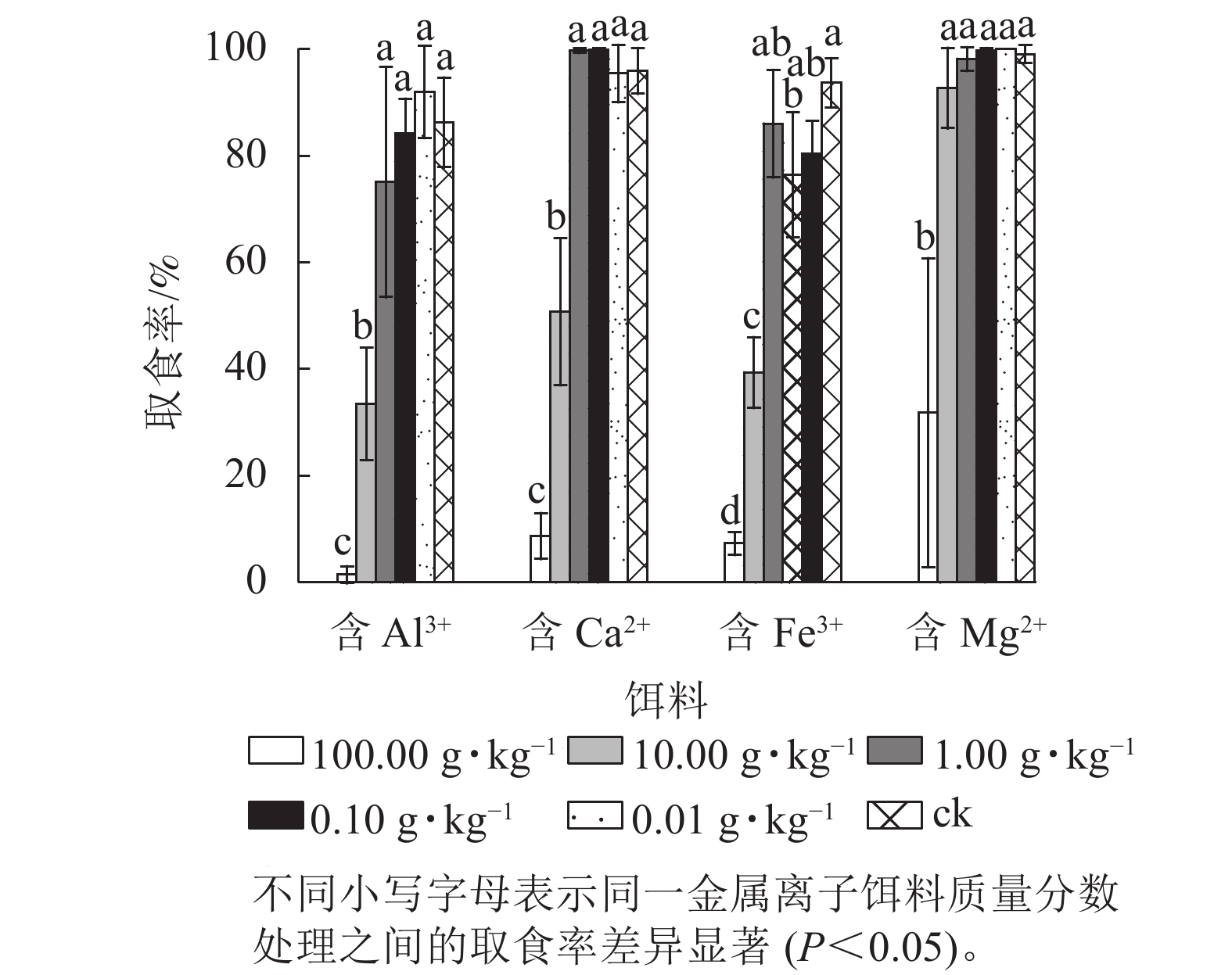-
中国每天产生约5万t厨余垃圾,占城市生活垃圾的40%~60%[1]。现有的厨余垃圾处理模式中,饲料化的环境效应最好且成本效益高[2]。利用资源昆虫进行垃圾处理是目前厨余垃圾资源化利用的研究热点,拟黑多刺蚁Polyrhachis vicina幼蚁、黑水虻Hermetia illucens、黄粉虫Tenebrio molitor等昆虫均可以作为资源昆虫处理垃圾[3−5]。黑水虻可有效分解厨余垃圾并将其转化为油脂和蛋白质等高价值生物质[6],黄粉虫幼虫对厨余垃圾的利用率可达38.88%[7]。厨余垃圾含有一定量的金属元素,一般较难对其进行有效处理[8−10]。有研究表明:白蚁与微生物的共同作用,可使木质纤维素材料得到高效的利用[11],据统计,白蚁1 a可以消耗30~70亿t木质纤维素[12]。白蚁还可以通过取食腐烂的有机物和木材,富集重金属[13]。在培菌白蚁肠道和菌圃中存在不同质量分数的金属离子,这些金属离子可能对肠道共生微生物和木质纤维素降解酶的活力有一定影响[14−16]。白蚁肠道系统中许多种酶需要与某些金属离子相结合,来实现其催化活性,这些酶的催化活性在许多生物过程中起到至关重要的作用,例如产氢过程、呼吸过程和碳水化合物水解过程等[17−18]。
黑翅土白蚁Odontotermes formosanus对林木、绿化、堤坝等具有严重危害性,但同时也是一种重要的资源昆虫,在自然环境下,它可以高效降解木质纤维素[19]。黑翅土白蚁是否具有处理厨余垃圾的潜力目前尚不明确。本研究拟探究食物中含有的Al3+、Ca2+、Fe3+和Mg2+对黑翅土白蚁消化代谢的影响,为生产上仿生利用黑翅土白蚁来处理农林废弃物和厨余垃圾提供了新的思路。
-
供试黑翅土白蚁蚁巢采自福建省三明市大田县,带回室内在26 ℃避光条件下饥饿3 d后供处理。供试饵料为桂花Osmanthus fragrans枯枝木屑,采自浙江大学紫金港校区校友林,在80 ℃烘箱内烘48 h,研磨过20目筛;在100 ℃烘箱内烘24 h后备用。无水三氯化铝、无水氯化钙、无水三氯化铁和无水硫酸镁均为分析纯,购自沪试国药集团化学试剂有限公司。漆酶(laccase)和纤维素酶(cellulase)试剂盒购自苏州梦犀生物医药科技有限公司。
-
将无水三氯化铝用去离子水稀释至100.00、10.00、1.00、0.10、0.01 g·L−1 5个质量浓度,以去离子水为对照(ck)。每个处理取10.00 mL,分别与10 g木屑混合均匀,静置24 h后置于80 ℃烘箱中烘干48 h,得到含有Al3+质量分数分别为100.00、10.00、1.00、0.10、0.01 g·kg−1的5组Al3+饵料处理组和ck饵料。将饵料分别装入1.50 mL离心管中并压实,用电子天平称量获得饵料质量。取3个直径一致的蚁巢,在每个蚁巢中同时放入6组饵料。15 d后取出离心管,80 ℃烘干至恒量,去除泥土后称量剩余饵料质量,计算取食率,取平均值。与对照组无显著差异的Al3+最大质量分数为黑翅土白蚁对该金属离子的最大可取食质量分数。其他3种金属离子的最大可取食质量分数测定同上。分别以含最大可取食质量分数的Al3+、Ca2+、Fe3+、Mg2+饵料饲喂黑翅土白蚁,共4个处理组,以去离子水处理的饵料为对照(ck),设3次重复,持续饲喂30 d。
-
参考LI等[16]的方法。在蚁巢中随机挑选10只体长为0.45±0.05 mm 的低龄工蚁置于PTFE烧杯中,加入5.00 mL浓硝酸后,用封口膜密封,依次于80 ℃加热盘上加热1.0 h,160 ℃加热1.5 h,蒸发约0.50 mL。用孔径为0.22 μm的水系滤膜过滤,取0.75 mL滤液用去离子水定容至25.00 mL,得到体积分数约3%的浓硝酸稀释液。每个处理重复3次,使用电感耦合等离子发射光谱仪测定金属元素。
-
参考TOYAMA-KATO等[20]的方法。称取0.1 g上层菌圃于PTFE烧杯中,加入1.00 mL浓硝酸后,用封口膜进行密封。置于60 ℃加热盘上加热4.0 h后向烧杯内加入1.00 mL浓硝酸,再依次在加热盘75 ℃加热0.5 h,130 ℃加热0.5 h,最后200 ℃加热0.5 h。冷却后向烧杯内加入10.00 mL浓硝酸复溶,用孔径为0.22 μm的水系滤膜进行过滤,后续处理同1.2.2。
-
采用分光光度法对黑翅土白蚁工蚁及新建菌圃中的漆酶和纤维素酶活力进行测定,参照试剂盒说明书进行操作。
-
数据均为平均值±标准差,使用SPSS 26进行单因素方差分析,采用LSD法进行多重比较。
-
黑翅土白蚁对含Al3+、Ca2+和Fe3+饵料的最大可取食质量分数均为1.00 g·kg−1,对含Mg2+饵料的最大可取食质量分数为10.00 g·kg−1(图1)。对Al3+、Ca2+ 、Fe3+和Mg2+ 4种金属离子而言,黑翅土白蚁总体上偏好取食质量分数较低的饵料。同时,在供试的4种金属离子中,黑翅土白蚁对Mg2+的接受程度最高。
-
取食含有1.00 g·kg−1 Al3+、Ca2+或Fe3+的饵料后,黑翅土白蚁虫体对应的金属元素Al、Ca和Fe质量分数与ck之间无显著差异(图2A~C)。取食含有1.00 g·kg−1Ca2+的饵料后,黑翅土白蚁虫体内Al质量分数最低,与ck差异显著(P<0.05)。由图2D可见:取食含有10.00 g·kg−1Mg2+饵料后,黑翅土白蚁虫体内Mg 质量分数最高,为6.18 mg·g−1,与ck和取食其他3种金属元素的均差异显著(P<0.05)。说明只有取食含有10.00 g·kg−1 Mg2+的饵料,Mg会在黑翅土白蚁体内富集,而其他3种金属元素不会在黑翅土白蚁体内富集。
-
取食含有1.00 g·kg−1 Al3+或Ca2+的饵料后,其菌圃内对应的金属元素Al和Ca质量分数与ck之间无显著差异(图3A~B)。取食含有1.00 g·kg−1 Fe3+或含有10.00 g·kg−1Mg2+的饵料后,菌圃内对应的Fe质量分数为1.29 mg·g−1,Mg为2.52 mg·g−1,均显著高于ck (P<0.05)(图3C~D)。其中取食含有10.00 g·kg−1Mg2+饵料后菌圃内的Al质量分数较ck显著提高(P<0.05),取食含有1.00 g·kg−1 Al3+、Ca2+、Fe3+的饵料后,菌圃中Mg质量分数较ck显著降低(P<0.05)。说明取食含金属离子的饵料对黑翅土白蚁新建菌圃内相应金属元素质量分数有一定影响。就本研究而言,黑翅土白蚁取食含有1.00 g·kg−1 Fe3+或含有10.00 g·kg−1·Mg2+饵料后,对应的金属元素Fe和Mg会在菌圃中富集。
-
表1数据表明:1.00 g·kg−1 Al3+、Ca2+和Fe3+显著促进了黑翅土白蚁虫体内的漆酶活性(P<0.05),说明上述质量分数的3种金属离子可提高白蚁的木质素降解能力;1.00 g·kg−1 Fe3+显著抑制了新建菌圃内的漆酶活性(P<0.05),其酶活性仅为62.91 nmol·g−1·min−1,但被摄入食物中的10.00 g·kg−1 Mg2+显著促进(P<0.05),酶活性达到了419.65 nmol·g−1·min−1,说明Fe在菌圃富集会降低菌圃微生物的木质素降解能力,而Mg正好相反。1.00 g·kg−1 Ca2+和Fe3+显著抑制了黑翅土白蚁虫体内的纤维素酶活性(P<0.05),但10.00 g·kg−1 Mg2+则对该酶起到显著促进作用(P<0.05),说明不同金属离子在白蚁体内可能存在竞争关系,且Mg的富集会提高黑翅土白蚁虫体内的纤维素降解能力。1.00 g·kg−1 Fe3+显著促进了新建菌圃中的纤维素酶活性(P<0.05),其酶活性为1 098.77 μg·g−1·min−1,但10.00 g·kg−1 Mg2+显著抑制了新建菌圃中的纤维素酶活性(P<0.05),其酶活性为745.40 μg·g−1·min−1。说明Fe在菌圃富集会提高菌圃微生物的纤维素降解能力,而Mg在菌圃富集则会降低菌圃微生物的纤维素降解能力。
处理 漆酶活性/(nmol·g−1·min−1) 纤维素酶活性/(μg·g−1·min−1) 虫体 菌圃 虫体 菌圃 ck 2.84±0.66 c 227.79±18.67 b 1129.21±111.55 b 923.25±31.04 b Al 15.65±2.48 a 151.11±17.25 bc 1253.91±54.33 b 932.67±36.95 b Ca 9.81±0.44 b 146.36±40.72 bc 682.67±70.10 c 907.02±34.90 b Fe 7.38±1.30 b 62.91±7.74 c 615.41±83.35 c 1098.77±108.31 a Mg 1.90±0.64 c 419.65±18.62 a 1600.71±13.19 a 745.40±32.09 c 说明:Al指含有1.00 g·kg−1 Al3+饵料;Ca指含有1.00 g·kg−1 Ca2+饵料;Fe指含有1.00 g·kg−1 Fe3+饵料;Mg指含有10.00 g·kg−1 Mg2+饵料。不同小写字母表示不同处理间差异显著(P<0.05)。 Table 1. Activities of laccase and cellulase in the body of O. formosanus and in new-built fungus combs
-
白蚁富含蛋白质、维生素和许多必需的矿物质元素[21] ,可以食用;培菌白蚁的共生真菌蚁巢伞,味道鲜美,营养价值高,研究还发现蚁巢伞属真菌具有镇痛抗炎、防癌抗癌、降血脂及抗氧化等药理作用和生物功能活性[22]。在本研究中,取食含有1.00 g·kg−1 Al3+、Ca2+、Fe3+或10.00 g·kg−1 Mg2+的饵料后,黑翅土白蚁仍可进行正常的生理活动并构建菌圃,由此可以看出黑翅土白蚁具有处理含有一定质量分数金属离子的厨余垃圾和农林废弃物的潜力。
培菌白蚁可以在肠道微生物的帮助下有效分解木质纤维素,菌圃内的细菌[23]可以通过产生包括纤维素酶在内的大量降解木质纤维素的酶,来实现与蚁巢伞协同降解木质纤维素的功能[24]。培菌白蚁的共生蚁巢伞可以产生纤维素酶、果胶质水解酶类、木聚糖酶等,同时也能产生与木质素分解有关的漆酶,培菌白蚁可以利用共生蚁巢伞高效降解木质纤维素[25−26]。LI等[27]发现Al3+对解淀粉芽孢杆菌漆酶活性有促进作用,与本研究中1.00 g·kg−1 Al3+能够促进黑翅土白蚁虫体内的漆酶活性结果一致,在饵料中添加1.00 g·kg−1 Al3+有利于提高黑翅土白蚁及其菌圃微生物联合降解木质素的能力,而不会显著影响纤维素降解能力,对黑翅土白蚁的资源性利用具有现实意义。肖东来等[28]研究发现Mg2+对香菇 Lentinuda edodes 羧甲基纤维素酶活性具有激活作用,而WANG等[29]的研究结果表明较高质量分数的Mg2+能够抑制黄粉虫纤维素酶活力。在本研究中,10.00 g·kg−1 Mg2+抑制了菌圃内的纤维素酶活性,却促进了黑翅土白蚁虫体内的纤维素酶活性,一方面是因为同种金属离子对不同来源的同一类酶的影响程度可能不同[30];另一方面,LI等[19]的研究已经证实白蚁和菌圃微生物对木质素的降解具有互补性,推测黑翅土白蚁能够通过自身和菌圃微生物对木质纤维素降解的互补性来抵抗一定质量分数金属离子的负面影响,有关金属离子对木质纤维素降解酶的联合影响有待进一步研究。
-
本研究确定了黑翅土白蚁对饵料中Al3+、Ca2+和Fe3+的最大可取食质量分数均为1.00 g·kg−1,对饵料中Mg2+的最大可取食质量分数为10.00 g·kg−1。金属元素Mg能够在黑翅土白蚁虫体内和菌圃内富集,不同金属离子对黑翅土白蚁虫体和菌圃内漆酶和纤维素酶活性的影响不同,其中1.00 g·kg−1 Al3+可以提高黑翅土白蚁及其菌圃微生物联合降解木质素的能力。黑翅土白蚁具有对含有金属离子的厨余垃圾和农林废弃物进行资源化处理的应用潜力,今后需要进一步研究混合金属离子对黑翅土白蚁消化代谢的影响,以推动其资源化处理厨余垃圾和农林废弃物的实际应用。
Effects of metal ions on digestion and metabolism of Odontotermes formosanus
doi: 10.11833/j.issn.2095-0756.20230219
- Received Date: 2023-04-03
- Accepted Date: 2023-06-12
- Rev Recd Date: 2023-06-08
- Available Online: 2024-01-19
- Publish Date: 2024-02-20
-
Key words:
- Odontotermes formosanus /
- fungus combs /
- metal ion /
- enzyme activity
Abstract:
| Citation: | QI Mengwen, SHEN Yi, YANG Guiying, et al. Effects of metal ions on digestion and metabolism of Odontotermes formosanus[J]. Journal of Zhejiang A&F University, 2024, 41(1): 154-160. DOI: 10.11833/j.issn.2095-0756.20230219 |













 DownLoad:
DownLoad:

